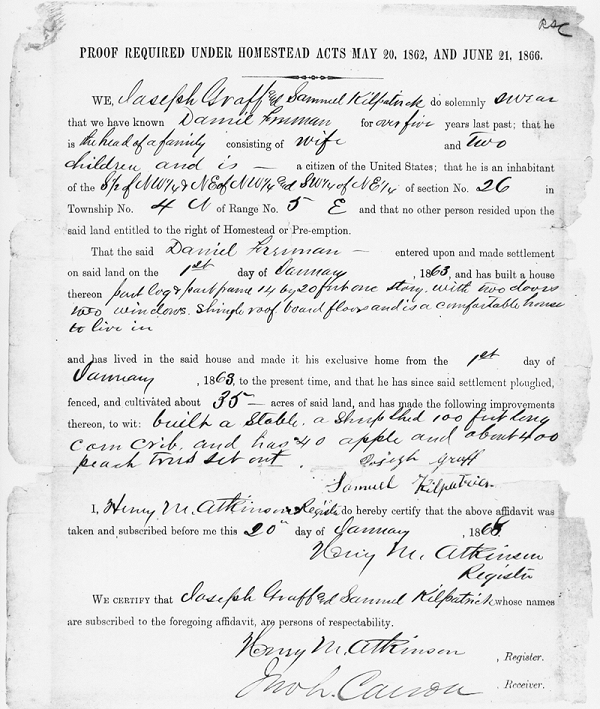
Few laws passed by the United States have had such a profound effect on the society as have the series of Homestead Acts beginning in 1862. Beginning with the formation of the United States of America with the passage of the U. S. Constitution in 1789 the Federal Government officially claimed ownership to land under Article Four, Section 3 and Clause 2 of the Constitution that reads as follows:
The Congress shall have power to dispose of and make all needful Rules and Regulations respecting the Territory or other Property belonging to the United States; and nothing in this Constitution shall be so construed as to Prejudice any Claims of the United States, or of any particular State.Any genealogical research in the United States that goes back into the 1800s and involves any degree of land ownership absolutely requires investigation of the possibility of a Homestead Claim.
Before the passage of the first Homestead Act in 1862, the condition of the Federal land ownership was unsettled as described by this passage from the U.S. National Archives article "Teaching with Documents: The Homestead Act of 1862."
The distribution of Government lands had been an issue since the Revolutionary War. At the time of the Articles of Confederation, the major controversy related to land measurement and pricing. Early methods for allocating unsettled land outside the original 13 colonies were arbitrary and chaotic. Boundaries were established by stepping off plots from geographical landmarks. As a result, overlapping claims and border disputes were common. The Land Ordinance of 1785 finally implemented a standardized system of Federal land surveys that eased boundary conflicts. Using astronomical starting points, territory was divided into a 6-mile square called a township prior to settlement. The township was divided into 36 sections, each measuring 1 square mile or 640 acres each. Sale of public land was viewed as a means to generate revenue for the Government rather than as a way to encourage settlement. Initially, an individual was required to purchase a full section of land at the cost of $1 per acre for 640 acres. The investment needed to purchase these large plots and the massive amount of physical labor required to clear the land for agriculture were often insurmountable obstacles.This situation was partially resolved through a series of adjustments to the original sales laws, but full restructuring of the Federal land issues wasn't accomplished until the passage of the Homestead Act during the U.S. Civil War period. Subsequently, additional acts were passed affecting the procedures and processes for land acquisition from the Federal Government. The original act was model for the passage of the subsequent legislation. Here is a brief description of the original process from the U.S. National Archives:
With the secession of Southern states from the Union and therefore removal of the slavery issue, finally, in 1862, the Homestead Act was passed and signed into law. The new law established a three-fold homestead acquisition process: filing an application, improving the land, and filing for deed of title. Any U.S. citizen, or intended citizen, who had never borne arms against the U.S. Government could file an application and lay claim to 160 acres of surveyed Government land. For the next 5 years, the homesteader had to live on the land and improve it by building a 12-by-14 dwelling and growing crops. After 5 years, the homesteader could file for his patent (or deed of title) by submitting proof of residency and the required improvements to a local land office.Again from the U.S. National Archives, here is an example of one of the very first Homestead Applications from Daniel Freeman.

Here is his Proof of Improvements.

Finally, his Certificate of Eligibility

But before I get into a discussion of the land ownership issues that evolved because of the various Homestead Acts and the documents that you might find that will help with genealogical research, I want to mention several websites that give a huge amount of information about the land titles and patents. The first database is from HistoryGeo.com. This is a subscription website that has the following called the First Landowners Project. This is available at the Brigham Young University Family History Library and has proved to be a very interesting and useful website.
Instead of looking at landowner maps township by township, imagine what it would be like to have a SINGLE, INTERACTIVE MAP containing over 12.3 MILLION LANDOWNERS among 30 states (all 29 of the public land states in the Continental U.S., plus Texas). Imagine constantly expanded map coverage, and having the ability to keep track of all the early homesteaders you're researching. Imagine...wait, you don't have to imagine. IT'S HERE, and AVAILABLE NOW to Our Subscribers!In addition, see the following;
“Home - BLM GLO Records.” Accessed June 8, 2016. http://www.glorecords.blm.gov/default.aspx.
“Homestead Records Genealogy - FamilySearch Wiki.” Accessed June 8, 2016. https://familysearch.org/wiki/en/Homestead_Records.
“Homestead Records - Homestead National Monument of America (U.S. National Park Service).” Accessed June 8, 2016. https://www.nps.gov/home/learn/historyculture/homesteadrecords.htm.
“Land Records.” Accessed June 8, 2016. https://www.archives.gov/research/land/.
“U.S., Homestead Records, 1861-1936.” Accessed June 8, 2016. http://search.ancestry.com/search/db.aspx?dbid=60593.




The FS wiki article on the BLM Tract Books has research tips that users may find more helpfully detailed than the wiki article on Homestead Records (which does not have a link to the immensely useful table of tract book contents):
ReplyDeletehttps://familysearch.org/wiki/en/United_States,_Bureau_of_Land_Management_Tract_Books_%28FamilySearch_Historical_Records%29
and the table:
https://familysearch.org/wiki/en/United_States,_Bureau_of_Land_Management_Tract_Books_Coverage_Table_%28FamilySearch_Historical_Records%29